Of all ‘classical’ communities, early-music ensembles should have a historically informed understanding of the atmosphere and audience interaction within performance spaces.
This story was originally published in the January 2023 issue of EMAg, the Magazine of Early Music America
In addition to being a professional early-music ensemble director, performer, and educator, I am also a mom; juggling these jobs during a pandemic was a surreal learning experience. My daughter was born in July 2020 and, like many, I had to make countless accommodations to ensure that the needs of my family, students, and collaborators were met. When schools returned in-person, she came with me to class and continued to assimilate to my music-making throughout her babyhood. There were no alternatives for me, a parent with a child under five who, at the time, was still ineligible for the COVID vaccine.
Naturally, she also tagged along with me to last summer’s early-music events. All went swimmingly—until we were kicked out of an early-music concert.

Despite her lifelong training as an audience member, my daughter is still just a toddler. I know better than to expect her to sit still, although I monitor her volume and am of course quick to escort her out of a concert hall if she starts to fuss. At this particular performance, my daughter nursed in my lap for the first half hour and then decided she wanted to roam the aisles silently. The audience was very small, maybe a dozen people. I paced nearby, also in complete silence, ready to intervene if needed, meanwhile listening intently to the performers onstage, fully appreciating their artistry and admiring their perseverance during such a difficult time. When my daughter walked up the aisle to meet me at the back of the hall, the ensemble director—a professional colleague—said to me, “Remove the child from the hall.”
Here’s how this all pertains to diversity, equity, and inclusion: when children are not welcome in our concert halls, we also ostracize their caretakers, who are often women. If an arts organization genuinely cares about DEI, they need to show it in more ways than just programming. Inclusive programming is not enough to create an inclusive community experience. And if we continue to police our audience, we reinforce a narrative that says, “You do not belong here.”
Luckily, conversations about diversifying performers are happening. As we watch with horror as our audiences shrink and fade, like our polar ice caps, we should explore ways to grow and diversify early-music participants both on and off stage.
We say we want our concert halls to be community spaces that welcome everyone. Then we need to commit to doing the hard work of making those spaces inclusive. We need to reframe our expectations around “audience etiquette,” the buttoned-up classical expectation that audiences remain perfectly still, and yes, perfectly silent.
I understand this goes against the pretense that music is paint that is splashed on a canvas of silence. Of all “classical” communities, early-music ensembles should perhaps have the most historically informed understanding of the atmosphere and audience interaction within performance spaces. By comparison to audiences who used to talk, eat, drink, smoke, and throw vegetables at performers, a few seconds of candy-wrapper opening is hardly noisy.
When a period ensemble chooses to adhere to modern expectations for an invisible and inaudible audience, they make the choice to ostracize everyone not able to conform to these standards. I am referring now not only to children—our future audiences, performers, and patrons—but also adults with conditions like Tourette’s, Autism Spectrum Disorder, and countless other syndromes. Adults who are pregnant or suffer from sciatica. Adults like my father whose knees and hips prevent him from sitting in one position for too long. And so many others without even beginning to mention communities of people who just haven’t been indoctrinated into the classical-audience culture, who are shushed for clapping between movements.
As an ensemble director deeply invested in the success of my musicians (both student and professional), I empathize with the desire to create distraction-free concert spaces, especially when the performance is being recorded for potential career use. To this end, I challenge audition committees to revise their expectations and celebrate recorded evidence of audience interaction rather than penalizing it.
Not only does the current attitude prioritize the needs of the performer above the audience, but it also undervalues our human ability to focus our minds and bodies within stimulating—a word I prefer to “distracting”—spaces. And somehow the audience at a jazz club, listening to acoustics instruments, can drink and move around and applaud a great solo while never losing their deep focus on the music. An alive audience enhances everyone’s experience.
I’ve had the privilege of teaching in several inclusive schools where students have excelled in learning alongside students who are simply not able to sit quietly in a chair. If my kindergarteners can do it, surely a conservatory-trained violinist can. The attempt to shield the musician from distraction is thus condescending to the performer. Our brains and bodies are amazing things that are capable of so much more than we admit!
Why not celebrate the unique interactions that a performer might have with a visibly inclusive and diverse audience? I say, let us see them. Let us hear them. Let us play for them, not at them.
Marylin Winkle performs and teaches widely. She directs the Early Music Ensemble at UCLA’s Herb Albert School of Music and is the artistic director of L.A. Camerata.

